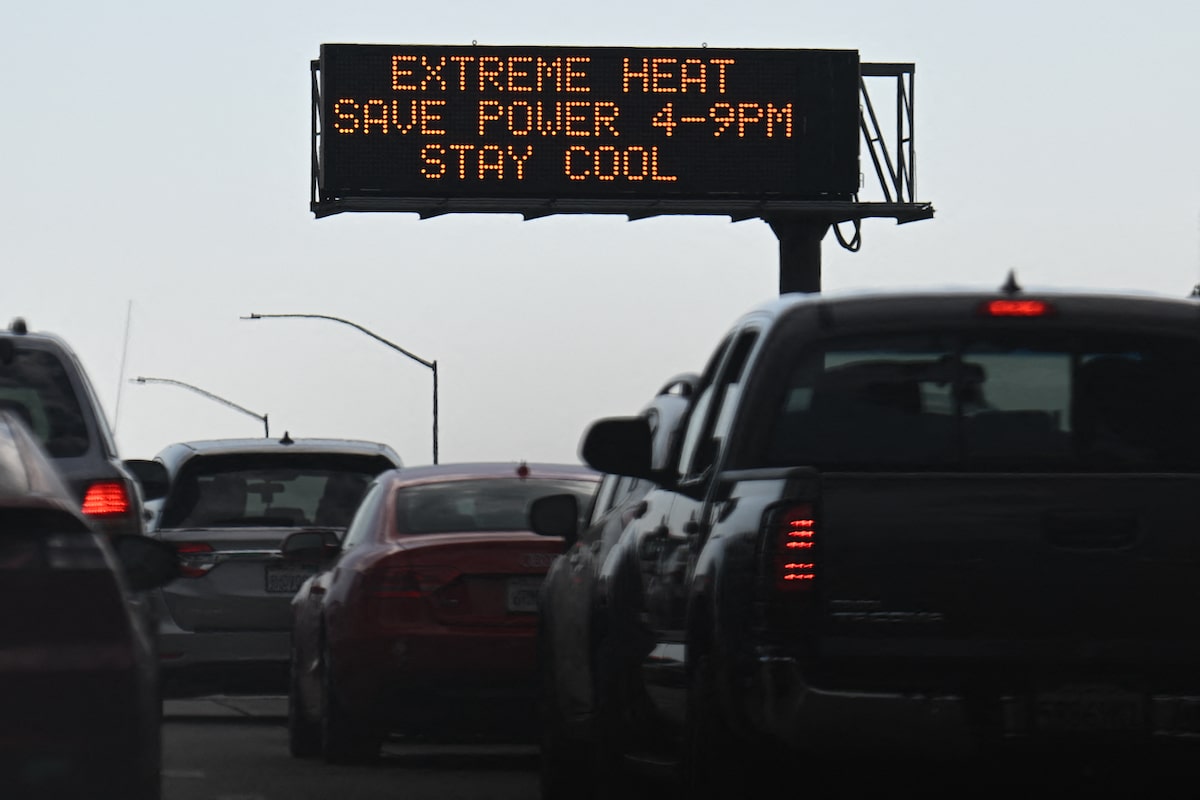Products You May Like
A road sign warns about high heat in Los Angeles on Sept. 2, 2022. PATRICK T. FALLON / AFP via Getty Images
 Why you can trust us
Why you can trust us
Founded in 2005 as an Ohio-based environmental newspaper, EcoWatch is a digital platform dedicated to publishing quality, science-based content on environmental issues, causes, and solutions.
The state of California entered September with record-breaking temperatures that strained its electrical grid.
The record toppling began Thursday, the first of the month, when Death Valley reported the highest temperature ever recorded in September on planet Earth. Then, on Monday, areas around the Bay Area recorded daily, monthly and one all-time high.
“It’s definitely record-setting,” National Weather Service (NWS) in Hanford, CA, lead meteorologist Bill South said, as The New York Times reported. “We get heat waves in September but rarely as intense as this one.”
The immediate cause of the high heat is a pressure dome that has moved westward and closed over California. On Thursday, it pushed the thermometer at Furnace Creek in Death Valley to 127 degrees Fahrenheit, as CBS News reported. That’s the highest temperature ever recorded anywhere on Earth during September.
“The ground heats up, we’ve measured temperatures of 201 as far as ground temperatures. The ground is then radiating heat back up into the air,” Death Valley National Park spokeswoman Abby Wines said, as CBS News reported.
Death Valley, however, is considered one of the hottest places on Earth. It holds the record for highest temperature ever recorded — 134 degrees Fahrenheit in 1913. But the heat wave also saw records break in the Bay Area. On Monday, the city of Gilroy matched its September high of 112 degrees Fahrenheit, SFGate reported. A temperature of 112 degrees Fahrenheit in Santa Rosa broke that city’s September high, while a reading of 116 degrees Fahrenheit in Livermore was the highest ever recorded in the Bay Area. The city of Fairfield also recorded a 116-degree temperature, the San Francisco Chronicle reported.
It’s possible that more records could be broken Tuesday — Fairefield could see even higher temperatures, according to the San Francisco Chronicle. Livermore is forecast to reach 118 degrees Fahrenheit, SFGate reported further.
“Early morning temperatures in the East Bay and higher terrain are running 5 to 10 degrees higher today than they were yesterday,” NWS forecaster Brooke Bingaman told SFGate. “That’s why they increased the forecast in Livermore up to 118.”
The cities of Stockton and Sacramento also broke September records Monday with temperatures of 112 degrees Fahrenheit and 113 degrees Fahrenheit respectively, according to NWS. Temperatures in Sacramento could reach 115 degrees Fahrenheit Tuesday, which would top the city’s all-time high of 114 degrees Fahrenheit.
In Southern California, Pasadena broke a daily record over the weekend, as The New York Times reported. The city of Fresno in the Central Valley was forecast to top its September high Tuesday.
All of this heat has put strain on California’s electrical grid. The grid’s managers declared and then canceled an emergency on Monday, and managed to end the holiday weekend without blackouts, The Sacramento Bee reported. However, blackouts are still a possibility for Tuesday, as the state gets back to work amidst the high heat. It is possible that demand could break a 16-year record and reach 51,144 megawatts.
“We are on razor thin margins,” vice chairman of the California Energy Commission Siva Gunda said, as The Sacramento Bee reported.
The high temperatures are also fanning the flames of wildfires: the Mill Fire and Mountain Fire are raging in Northern California while the Route Fire is burning in Southern California, The Washington Post reported. The Mill Fire claimed two lives, burned 50 structures and forced around 1,000 to evacuate, CNN reported.
The climate crisis is making heat waves more frequent and extreme. That said, California cities have been reporting record-breaking temperatures for more than 50 years, The New York Times pointed out.
“Obviously, climate change is real and very important, and we must move aggressively,” University of Colorado Boulder environmental science professor Roger Pielke Jr. told The New York Times. “But it’s not like there’s a safe climate that we’ve turned into a dangerous one.”
On the other hand, research meteorologist Alexander Gershunov of the Scripps Institution of Oceanography told The Washington Post that there was something different about the current California heat waves: They are more humid.
“With higher humidity, temperatures don’t really drop that much at night,” he said. “And in terms of health impacts, that pretty much removes the nighttime respite that we need to face another day of scorching heat.”
He also said that more frequent, intense heat waves were to be expected as global temperatures warm, as they are “the most closely-related and directly-impacted by global warming” of any extreme weather event.
Subscribe to get exclusive updates in our daily newsletter!
By signing up, you agree to the Terms of Use and Privacy Policy & to receive electronic communications from EcoWatch Media Group, which may include marketing promotions, advertisements and sponsored content.
